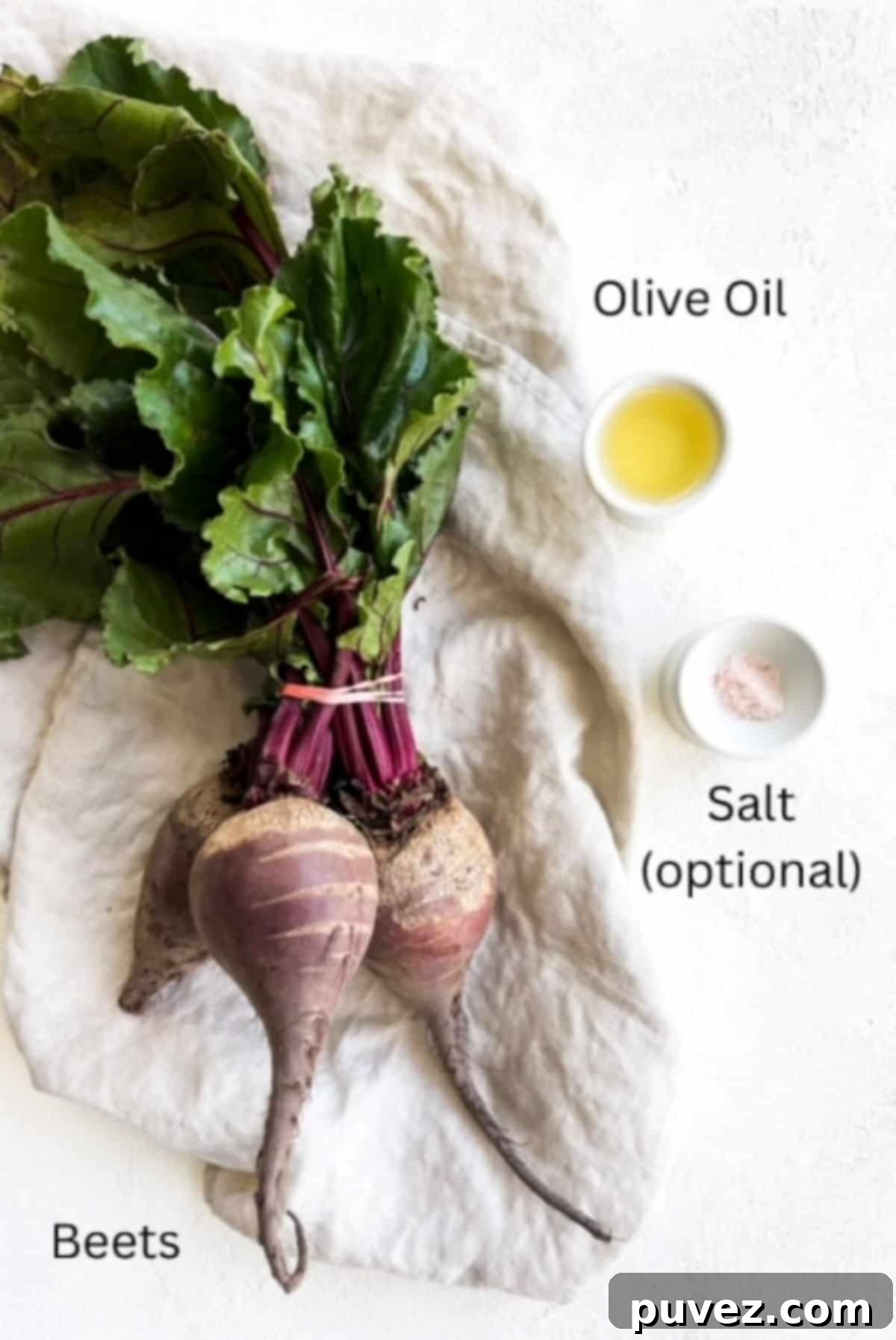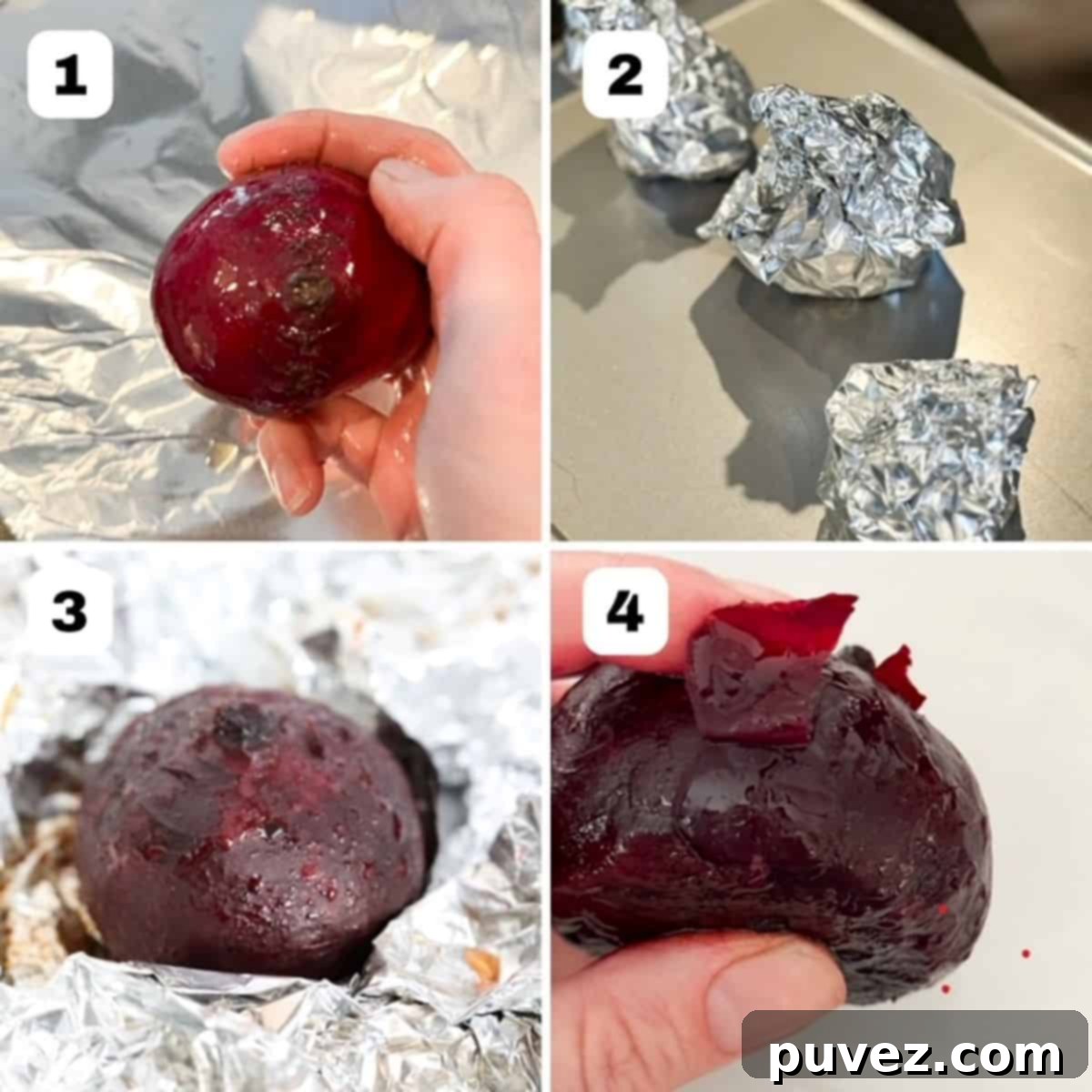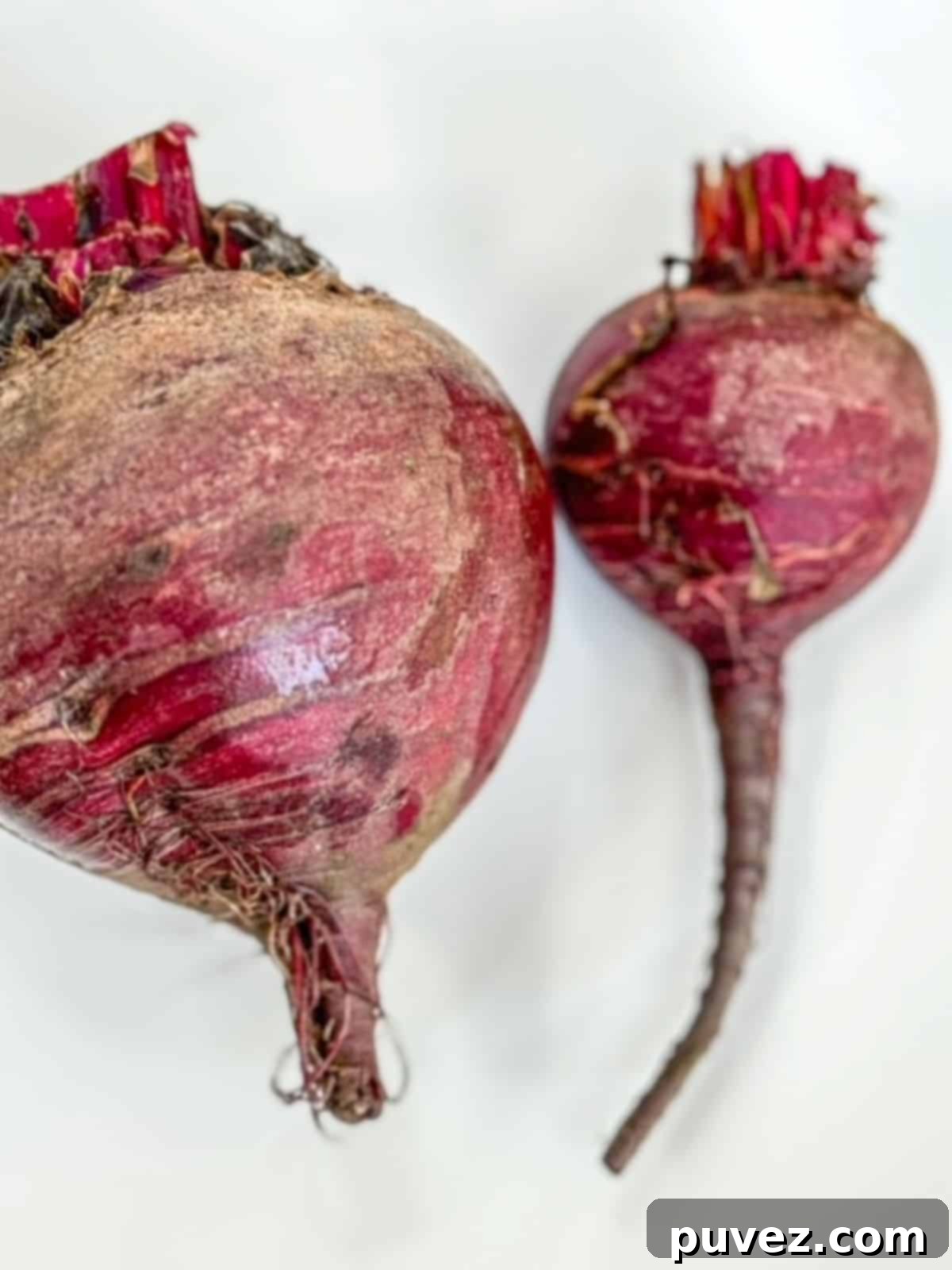Easy Roasted Beets in Foil: A Dietitian’s Guide to Perfectly Cooked Beetroot (Oven & Air Fryer)
Welcome to the ultimate guide for making incredibly tender and flavorful roasted beets in foil! If you’ve ever thought cooking whole beets was a chore, prepare to have your mind changed. This simple, two-ingredient method, perfected by a registered dietitian, yields restaurant-quality results every time, whether you’re using an oven or an air fryer. Say goodbye to messy kitchens and hello to vibrant, nutritious beetroot that’s ready to elevate any meal.

All you truly need for this incredibly simple roasted beets recipe are fresh beets (also universally known as beetroot), a modest amount of high-quality olive oil, and some tin foil. That’s it! This minimal ingredient list ensures the natural, earthy sweetness of the beets shines through, creating a truly delightful culinary experience.
As a registered dietitian, I’ve always been captivated by beets, not just for their stunning, vibrant color but also for their impressive nutritional profile. However, it wasn’t until I became a busy mom that I truly delved into discovering practical, delicious, and easy methods for preparing and serving them. My goal was to find ways that even the pickiest eaters (and adults!) would enjoy.
After experimenting with numerous cooking techniques – boiling, steaming, baking directly on a sheet pan – I unequivocally found that roasting beets wrapped tightly in foil is the absolute easiest and most effective method. This technique drastically reduces hands-on time, eliminates sticky cleanup, and consistently produces perfectly tender, flavorful beets with minimal effort. It’s a game-changer for anyone looking to incorporate more wholesome vegetables into their diet without the fuss.
Why You’ll Love This Easy Roasted Beets Recipe
- Just 2 Ingredients: Simplicity is key! All you need are fresh beetroot and a very small amount of olive oil. These two ingredients magically transform into a delicious side dish. This minimalist approach allows the natural flavors of the beets to truly shine, making them incredibly versatile. It’s the same simple foundation you’d use to make healthy beet chips, proving that less is often more when it comes to flavor and nutrition.
- Perfect for Meal Prep: Roast a batch of beets on your prep day, then easily slice or dice them and store them in an airtight container in the fridge. Cooked beets will stay fresh for up to 5 days, making them an excellent ingredient to have on hand. They can be served as a simple, elegant side dish, added to refreshing salads, blended into smoothies, or incorporated into various other dishes throughout the week, saving you precious time during busy mealtimes.
- Effortless Cleanup: The beauty of roasting beets in foil lies in its unparalleled ease of cleanup. When the beets are wrapped tightly, all their vibrant juices are contained within the foil packet, preventing any sticky messes or stains on your baking sheet or air fryer basket. Once your perfectly roasted beets are done, simply unwrap them, discard the foil, and enjoy! No scrubbing, no soaking – just toss the foil, and you’re done. 🤩
- Packed with Nutrients: Beets are a powerhouse of nutrition! They are low in calories and fat, yet rich in essential vitamins and minerals like folate, manganese, potassium, and vitamin C. Furthermore, beets are known for their beneficial plant compounds, including powerful antioxidants and dietary nitrates, which may support heart health and exercise performance. Roasting them in foil helps retain these valuable nutrients, offering a wholesome addition to your diet.
Dietitian Tip: Encouraging Kids (and Adults!) to Try New Foods
As a registered dietitian, one of my core beliefs is the importance of creating a positive and pressure-free environment around food. It’s absolutely vital that we avoid pressuring our kids (or even our spouses, for that matter!) to try a new food. Setting expectations on whether they “should” or “will” like something can often backfire. Instead, I advocate for a gentle, consistent approach. It’s equally important to continue to serve fruits and vegetables in a variety of ways to increase exposure. Research suggests that repeated, non-pressured exposure can significantly lead to acceptance and enjoyment over time.
My own family serves as a perfect example of this principle. My oldest daughter developed a love for plain beets from her very first taste. In fact, she loved them so much that for a while, I had to switch to making golden beets just to vary things up a bit and prevent her from overdoing it on the red ones (which can lead to some surprising discoveries in the bathroom, haha!).
My other two children, however, weren’t as immediately enthusiastic about beets. Yet, I’ve consistently included them in our meals, always without comment or fanfare. I simply offer them as part of the meal, allowing them to choose whether to eat them. Just recently, I had a breakthrough moment when one of my other kids independently ordered a smoothie with beets in it at a cafe, and much to my delight, loved it! This experience reinforces my belief: continue to offer, remain patient, and let curiosity and repeated exposure do their work. Who knows? Perhaps she’ll be enjoying whole roasted beets on their own in the very near future!
Essential Ingredients for Roasted Beets

- Fresh Beets (Beetroot): A beet, famously known as beetroot, is a deeply colored root vegetable celebrated for its earthy taste and sweet undertones. When choosing beets, look for firm, smooth roots with vibrant, healthy-looking greens (if attached). Avoid any that are soft, shriveled, or bruised. Beets are incredibly nutrient-dense, packed with vitamins, minerals, and unique plant compounds that have been extensively studied for their positive impact on health. They’re particularly high in folate, manganese, and a good source of fiber, making them a fantastic addition to a balanced diet. Remember to scrub them thoroughly before cooking to remove any dirt.
- Olive Oil: I personally prefer and recommend using extra virgin olive oil for roasting. Its rich flavor complements the sweetness of the beets, and it contains healthy monounsaturated fats. Olive oil helps the beets tenderize beautifully in the foil and contributes to a lovely texture. While extra virgin is my top choice, any good quality olive oil or even avocado oil would work well. The goal is a light coating to help them steam and caramelize slightly.
-
Optional Enhancements (Not Essential, But Delicious): While the core recipe is just two ingredients, you can easily customize the flavor profile.
- Salt and Pepper: A pinch of sea salt and freshly ground black pepper can enhance the natural sweetness of the beets.
- Fresh Herbs: Rosemary, thyme, or a bay leaf added to the foil packet before roasting can infuse the beets with aromatic flavors.
- Garlic: A thinly sliced clove of garlic in the foil packet can add a subtle, savory depth.
Step-by-Step: How to Make Roasted Beets in Foil

Here is a detailed summary of how to roast beetroot in foil, ensuring perfect results every time. For a complete list of ingredients and full, printable instructions, simply scroll down to the dedicated recipe card below.
- Prepare the Beets: Begin by thoroughly washing your fresh beets under cold running water. Use a vegetable brush to scrub away any dirt or debris from the skins. Then, use a sharp knife to carefully cut off the beet greens, leaving about an inch of the stem attached to prevent excessive bleeding during roasting. You can save the greens for another use, like sautéing or adding to a smoothie!
- Oil and Season: Lay out individual square pieces of tin foil on your work surface – ensure each piece is large enough to fully encase a beet. Place one scrubbed beet in the center of each foil square. Drizzle a small amount of olive oil over each beet. Using your hands (gloves optional, but recommended to avoid staining!), gently rub the olive oil all over the entire surface of each beet, ensuring an even, thin coating. This helps with tenderness and flavor.
- Create Foil Packets: Carefully wrap each beet in its individual piece of foil, creating a sealed packet. Make sure the foil is crimped tightly around the beet to prevent any steam or juices from escaping. This creates a miniature steaming environment that helps the beets cook evenly and stay incredibly moist. Place the wrapped beets in a single layer on a rimmed baking sheet or in a baking dish.
- Roast to Perfection: Place your baking sheet with the foil-wrapped beets into a preheated oven or air fryer set to 425 degrees Fahrenheit (220°C). Roast for approximately 45 minutes, or until the beets are easily pierced with a fork (the exact time will depend on their size – see helpful tips below). Once cooked, carefully remove them from the oven or air fryer.
- Cool and Peel (Optional): Let the roasted beets cool in their foil packets for 5-10 minutes. This allows them to finish steaming and become easier to handle. If you plan to remove the skin, it’s easiest to do this while the beets are still slightly warm. Hold each beet under cold running water and gently rub the skin off with your fingers. The skin should slip off easily. If you prefer to eat the skins (which are nutritious!), simply slice and enjoy!
Helpful Tips for Perfect Roasted Beets

- Understand Cooking Time Variation: The cooking time for roasted beets will primarily depend on their size. As you can see in the picture above, beets come in a wide range of sizes, from small to very large. Smaller beets will naturally cook quicker, typically in about 35-40 minutes. Medium-sized beets, which are most common, generally take around 45 minutes to become fork-tender. For very large beets, you might need closer to an hour or even slightly longer. Always test for tenderness with a fork to ensure they are perfectly cooked.
- Oven vs. Air Fryer Consistency: In my experience, roasting beets wrapped in foil takes approximately the same amount of time whether you’re using a conventional oven or an air fryer. The foil creates a consistent cooking environment, minimizing differences between the appliances. If using an air fryer, ensure your foil packets fit comfortably without overcrowding the basket.
- Roasting Multiple Beets: When roasting more than one beet, it’s best to select beets of a similar size to ensure uniform cooking. Crucially, wrap each beet in its own separate piece of foil after coating it with olive oil. This individual wrapping allows each beet to steam perfectly. Once wrapped, arrange the foil packets in a single layer on your baking sheet or in the air fryer basket, as shown in the picture at the top of this post, to promote even heat distribution.
- Trimming the Greens and Stems: Before roasting, you should always cut off the leafy greens, leaving about an inch of the stem attached to the beetroot. This helps prevent the beet’s vibrant color and nutrients from “bleeding” out during cooking. You can trim the remaining small stem and root tip right before or after roasting – both ways yield similar results for the beet itself. Remember, beet greens are edible and delicious! Don’t toss them; sauté them like spinach or add them to a stir-fry.
- Less Oil is More in Foil: This recipe intentionally calls for a very small amount of olive oil compared to many other roasting recipes. The foil traps moisture, creating a steamy environment that tenderizes the beets beautifully without requiring excessive oil. A light drizzle is all you need to help with flavor and texture. For very large beets, you might need slightly more, but rarely more than half a teaspoon per beet.
- Peeling is Optional, Scrubbing is Essential: Deciding whether to peel the beet skins after roasting is a matter of personal preference. If you choose not to remove the skins, you’ll benefit from added fiber and nutrients, and save prep time. However, if you plan to leave the skins on, it’s even more critical to scrub the beets exceptionally well before roasting to ensure they are clean. If you’re leaving the skins on, there’s no need to rinse the cooked beets in cold water unless you want them to cool faster.
- Enhance Flavor with Herbs: If you’re not planning on peeling the skins (or even if you are!), consider adding fresh herbs like a sprig of rosemary or thyme, or even a small bay leaf, into the foil packet with the beet and olive oil before roasting. These aromatics will infuse the beets with wonderful additional flavor.
- Salt to Taste: Some individuals like to add a pinch or two of salt when coating the beets with oil. Personally, as a dietitian, I often find it unnecessary, especially if the roasted beets will be added to an already seasoned or salty dish, or if you plan to remove the skins. You can always add salt after roasting, to your preference.
- Prevent Staining: Beets have a powerful pigment that can temporarily stain your hands, cutting boards, and clothes. To avoid stained fingers when handling or peeling cooked beets, wear food-safe gloves. Don’t worry if you forget – beet stains on skin are temporary and will fade with washing.
Creative Ways to Serve Roasted Beets
Roasted beets possess a truly unique flavor profile – an earthy depth beautifully complemented by a delightful touch of sweetness from their natural sugars. Because of this harmonious blend, many people, myself included, find that beets are best enjoyed when paired with other complementary foods or flavors. Here are some of my favorite versatile and delicious ways to serve these perfectly roasted beets:
- Simple Side Dish: Enjoy them on their own, perhaps with a light drizzle of balsamic glaze, or elevate them by sprinkling with creamy goat cheese or salty feta for a classic, easy side dish that’s bursting with flavor and color. The tanginess of the cheese perfectly cuts through the beets’ sweetness.
- Elevated Avocado Toast: Transform your morning or afternoon snack by layering thin slices of roasted beets on top of your favorite avocado toast. This idea was directly inspired by a local restaurant and has quickly become my absolute favorite way to incorporate beets. The vibrant red against the green avocado creates a beautiful contrast, and the flavors meld wonderfully.
- Vibrant Roasted Beet Salad: Dice the cooked beets into bite-sized pieces to create a stunning roasted beet salad. They pair beautifully with mixed greens, toasted walnuts or pecans, a sprinkle of fresh herbs like mint or dill, and a light vinaigrette. You can even add them to, or substitute them for strawberries in, this refreshing strawberry goat cheese salad for a delicious twist.
- Warm Skillet Medley: For a comforting side, cut the cooked beets into smaller pieces and warm them gently in a skillet with a handful of toasted walnuts for crunch and a generous sprinkle of feta cheese. A touch of fresh parsley or chives at the end adds a burst of freshness, creating a warm and savory side dish.
- Beet Hummus or Dip: Puree leftover roasted beets with chickpeas, tahini, lemon juice, and garlic to make a gorgeous, naturally pink beet hummus. Serve with pita bread, vegetable sticks, or as a spread in sandwiches.
- In Grain Bowls: Add sliced or diced roasted beets to your favorite warm grain bowls alongside quinoa or farro, other roasted vegetables, leafy greens, and a protein source for a complete and wholesome meal.
- Smoothies: For a stealthy way to get more nutrients, blend a few small pieces of roasted beet into your morning smoothie. Their natural sweetness can complement fruits like berries and bananas without overpowering the flavor.
Frequently Asked Questions About Roasted Beets
Leftover roasted beets are incredibly versatile! You can easily transform them into a vibrant beet hummus by blending with chickpeas, tahini, lemon juice, and a touch of garlic. Another fantastic option is to thinly slice them and add them as a colorful and nutritious topping for avocado toast. For a surprising sweet treat, puree the leftover roasted beets and incorporate them into a chocolate cake batter – they add moisture, a beautiful hue, and a subtle earthiness that pairs wonderfully with chocolate. Yum!
To properly store cooked beets, first allow them to cool completely and come to room temperature. Once cooled, place them in an airtight container. They will keep beautifully in the refrigerator for 3-5 days. For longer storage, you can also freeze roasted beets for up to 3 months; simply slice or dice them before freezing for easy portioning.
Absolutely, yes! You can definitely eat roasted beets with the skin on. Even after roasting, the texture of the skin is noticeable, but it’s perfectly edible and delicious, offering a slightly chewier contrast. Plus, leaving the skin on is a fantastic way to boost your fiber intake and saves a significant amount of time during preparation since you don’t have to peel them. Just make sure to scrub the beets exceptionally well before roasting to ensure they are clean.
It is overwhelmingly easier to peel beets after they have been roasted. The roasting process tenderizes the skin, making it much simpler to remove. For the easiest peeling experience, I highly recommend peeling them while they are still a little warm, gently rubbing them under cold running water. The cold water helps cool the beet slightly and the skin practically slides right off.
I put this to the test myself: I roasted two beets, peeled one without running water and the other under cold running water. The difference was undeniable – peeling under running water was significantly easier and less messy.
Beets are nutritional powerhouses! They are rich in fiber, which aids digestion and promotes gut health. They contain high levels of folate, essential for cell growth and function, and manganese, crucial for bone development and metabolism. Beets are also a good source of potassium and Vitamin C. Most notably, they contain dietary nitrates, which the body converts into nitric oxide. This compound helps to relax and widen blood vessels, potentially leading to improved blood flow, lower blood pressure, and enhanced exercise performance.
Absolutely! This recipe works wonderfully with all varieties of beets, including golden beets, candy cane beets, and even white beets. While red beets are the most common and will create a vibrant, deep red color, golden beets offer a milder, slightly sweeter flavor and don’t stain as much. Candy cane beets are visually stunning with their red and white rings. The cooking method remains the same for all types, so feel free to mix and match for a beautiful and flavorful medley!
More Easy & Healthy Vegetable Recipes
- Air Fryer Beet Chips
- Perfectly Roasted Brussels Sprouts
- Hearty Roasted Autumn Vegetables
- Easy Roasted Peaches (Sweet Side Dish)
More Delightful Side Dish Recipes
- Easy Roasted Peaches
- Simple Lemon Garlic Salad Dressing
- Apple Cider Vinaigrette Dressing
- Easy Deviled Eggs Without Mustard
Did you discover how incredibly easy it is to roast whole beets in foil? If so, please take a moment to leave a comment below and a ⭐⭐⭐⭐⭐ rating. A 5-star rating is the highest compliment and helps others find this fantastic recipe!
Don’t miss out on more easy, dietitian-approved recipes and valuable nutrition tips! Follow me on Instagramor Pinterest.
📖 Recipe Card

Easy Roasted Beets in Foil
Kristi
Pin Recipe
5 minutes
45 minutes
5 minutes
55 minutes
Side Dish
American
3
half-cup servings
38
kcal
Equipment
-
1 baking sheet -
3 squares of tinfoil
Ingredients
-
3 medium-sized beets Greens removed and beets scrubbed well. Small- or large-sized beets can be used but cooking time will need to be adjusted. -
¼ teaspoon olive oil extra virgin
Instructions
-
Preheat your oven to 425℉ (220°C).
-
Tear off three squares of tin foil. Each piece should be generously sized, approximately 11×11 inches, to comfortably wrap around each beet.
-
Place one prepared beet (greens removed, scrubbed well) in the center of each individual piece of foil.3 medium-sized beets
-
Drizzle each beet with a small amount of olive oil, about ¼ teaspoon per beet. Use a basting brush or your hands to gently spread the oil, ensuring each beet is covered in a thin, even layer.¼ teaspoon olive oil
-
Individually wrap each beet tightly in its piece of foil, creating a sealed packet to trap steam and moisture.
-
Place the three individually wrapped beets on a baking sheet. Cook in the preheated oven or air fryer for 45 minutes, or until the beet is easily pierced and fork-tender.
-
Carefully remove the baking sheet from the oven/air fryer and let the beets rest in their foil packets for about 5 minutes before unwrapping. This helps them retain moisture.
-
If you plan on removing the skin, let the beets cool for another 5-10 minutes until they are still warm but manageable. Then, hold each beet under cold running water and gently rub the skins off with your fingers – they should slip away easily. Slice, dice, or cube as desired and enjoy!
Notes
- Thorough Cleaning: Always scrub your fresh beets very well before roasting, especially if you plan to eat them with the skins on.
- Trimming Options: The thick tops of each beet can be trimmed off before or after roasting. However, the beet greens should always be removed and saved for other uses before you begin roasting the roots.
- Drying Beets: Beets can air dry surprisingly quickly after washing. If they are still noticeably wet when you’re ready to add olive oil, pat them dry with a paper towel first to ensure the oil adheres properly.
- Adjust Cooking Time for Size: As noted, cooking time is heavily dependent on beet size. While medium beets typically take 45 minutes, smaller beets might be done in 35-40 minutes, and very large beets can take up to 55-60 minutes to achieve fork-tender perfection.
- Minimal Oil is Sufficient: For larger beets, you might find you need slightly more oil to ensure full coverage, but in my experience, I’ve rarely needed more than half a teaspoon of olive oil for a large beet, and for exceptionally large ones, close to a whole teaspoon. The foil does much of the work in locking in moisture.
- Optimal Peeling Temperature: If you decide to remove the skins, they come off most easily when the beets are still warm (but not scalding hot) and while running them under cold water.
- Oven vs. Air Fryer Performance: I’ve extensively tested this roasted beets recipe in both a conventional oven and an air fryer, and found the cooking times to be remarkably similar for foil-wrapped beets. This offers great flexibility depending on your kitchen setup and capacity needs.
- If using an air fryer, always refer to your specific manufacturer’s instructions for any unique guidance or recommendations for your model, especially regarding capacity and placement.
Nutrition
Serving:
3
half-cup servings
Calories:
38
kcal
Carbohydrates:
8
g
Protein:
1
g
Fat:
0.5
g
Saturated Fat:
0.1
g
Polyunsaturated Fat:
0.1
g
Monounsaturated Fat:
0.3
g
Sodium:
64
mg
Potassium:
267
mg
Fiber:
2
g
Sugar:
6
g
Vitamin A:
27
IU
Vitamin C:
4
mg
Calcium:
13
mg
Iron:
1
mg
Tried this recipe?
Let us know how it was!
